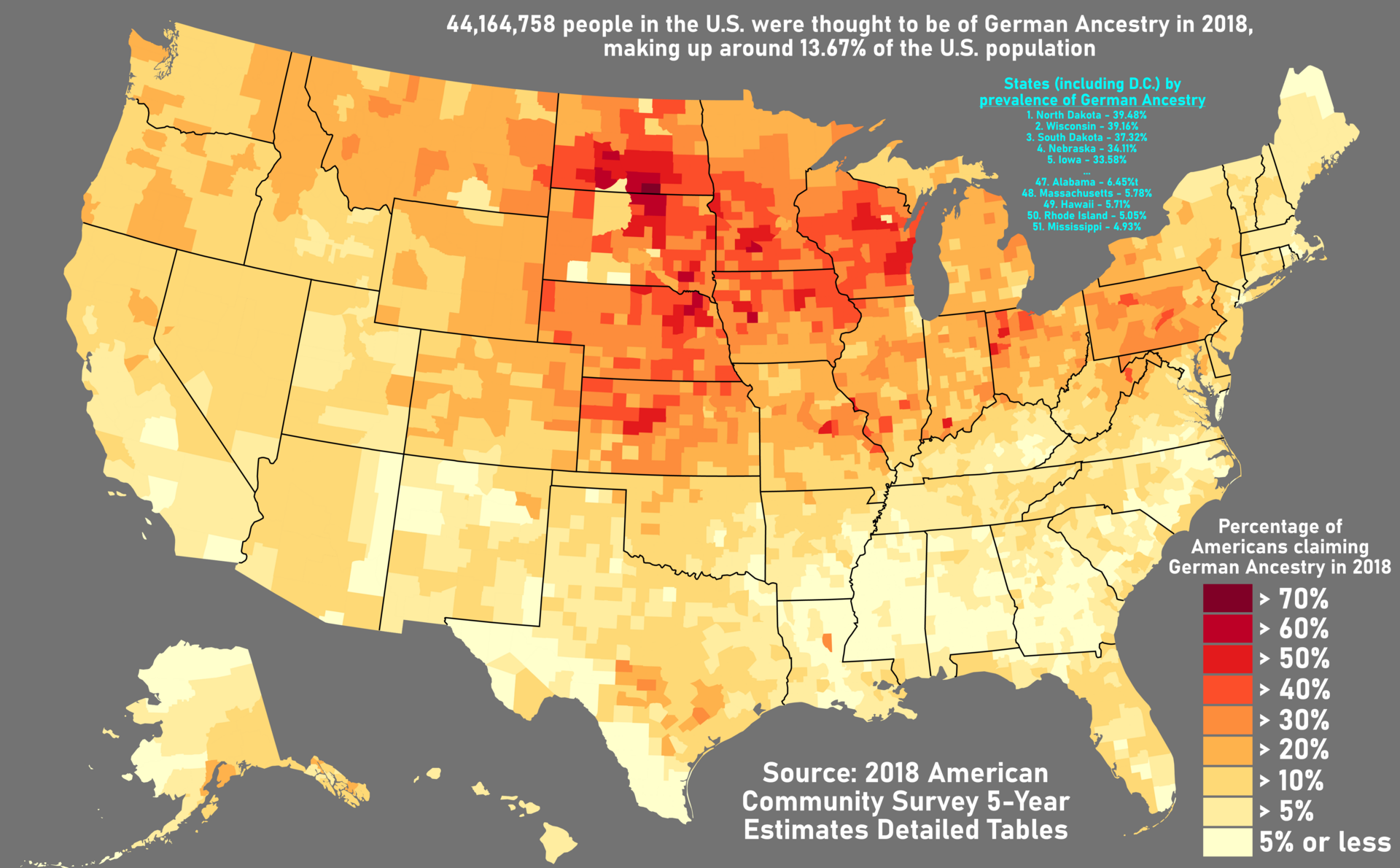Americans Claiming German Ancestry by County Map


David Chen
Data Visualization Specialist
David Chen is an expert in transforming complex geographic datasets into compelling visual narratives. He combines his background in computer science ...
Geographic Analysis
What This Map Shows
The visualization titled "Distribution of Americans claiming German Ancestry by county in 2018" provides a comprehensive look at the geographical spread of individuals in the United States who identify with German ancestry. The map illustrates the percentage of the population in each county that claims German heritage, revealing patterns that are deeply rooted in history and migration.
Interestingly, this map does more than just highlight where German Americans live; it tells a story of migration, settlement patterns, and the cultural fabric that has shaped various regions of the U.S. Ever wondered how a single ethnicity can leave such a significant mark on a nation? Let’s dive into the heart of this topic.
Deep Dive into German Ancestry in America
German immigrants began arriving in the United States in substantial numbers in the 17th century, with waves of migration peaking during the 19th century. The reasons for this migration were manifold: economic opportunity, political unrest, and a quest for religious freedom drove many Germans to seek a new life across the Atlantic. By the time of the 2018 census data reflected in the map, German Americans had established themselves as one of the largest ethnic groups in the country.
What’s fascinating is that German ancestry is not just about those who retain the culture and language; it has significantly influenced American customs, cuisine, and even local festivals. For instance, the Oktoberfest celebrations in cities like Cincinnati and Milwaukee are a testament to the lasting impact of German-American culture.
According to the 2018 data, the highest concentrations of German ancestry can be found in states like Wisconsin, Minnesota, and North Dakota. In these regions, counties can show upwards of 40% of the population claiming German roots. This concentration can be attributed to historical migration patterns, where entire communities settled together, establishing a strong cultural identity.
Furthermore, German Americans have played a pivotal role in shaping industries across the nation. From brewing to farming, their contributions can be seen in various sectors. The agricultural techniques brought over by German settlers, for instance, have had lasting impacts on farming practices in the Midwest, which remains a breadbasket of America today.
Regional Analysis
Examining the map reveals stark contrasts in German ancestry claims across different regions. In the Midwest, particularly in states like Wisconsin and Iowa, counties such as Waukesha and Dubuque show significant percentages (over 40%) of residents with German ancestry. This is largely due to the influx of German settlers during the 19th century, who established farms and communities that continue to thrive today.
In contrast, the Northeast, particularly in areas like New York, shows a more diverse ancestry mix, with German Americans constituting around 10-20% of the population in many counties. Interestingly, urban centers like New York City have a more varied demographic, reflecting waves of immigration from various countries, which has diluted the concentrations seen in the Midwest.
On the West Coast, areas like California have lower percentages of German ancestry, around 5-15%, as the state has been a melting pot for various immigrant groups, particularly from Asia and Latin America. However, cities like San Francisco still host a vibrant German cultural scene, albeit on a smaller scale.
Significance and Impact
Understanding the distribution of Americans claiming German ancestry is not just an academic exercise; it has real-world implications. This demographic data can influence everything from political representation to local cultural events. For instance, areas with higher concentrations of German Americans often celebrate their heritage through festivals, which can boost local economies.
Moreover, as the U.S. becomes increasingly diverse, the historical contributions of German Americans remind us of the rich tapestry of cultural influences that have shaped the nation. Current trends indicate a growing interest in genealogy and ancestral heritage, leading many to explore their roots, which may further influence the cultural landscape of various communities.
In conclusion, the distribution of Americans claiming German ancestry as depicted in the 2018 map is a reflection of historical migration patterns, cultural integration, and the ongoing evolution of American identity. As we move forward, understanding these patterns can help foster a greater appreciation for the diverse backgrounds that contribute to the American experience.
Visualization Details
- Published
- October 16, 2025
- Views
- 30
Comments
Loading comments...